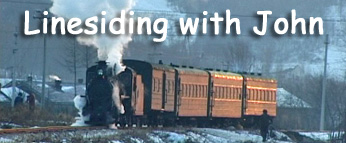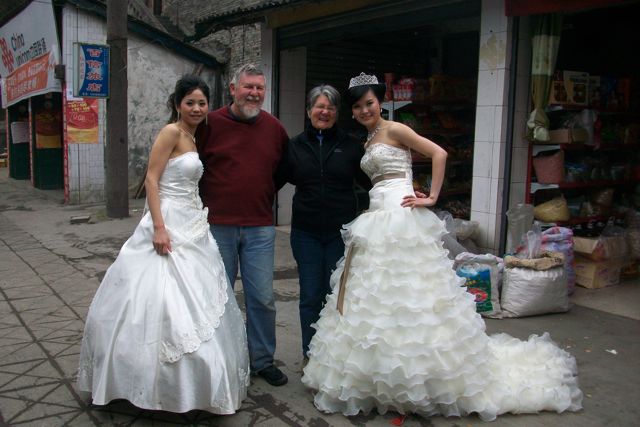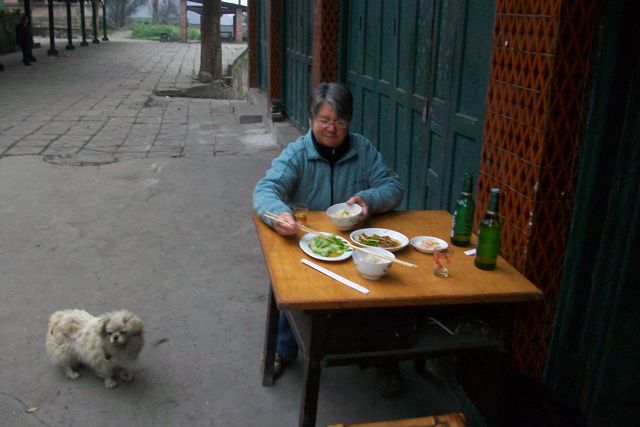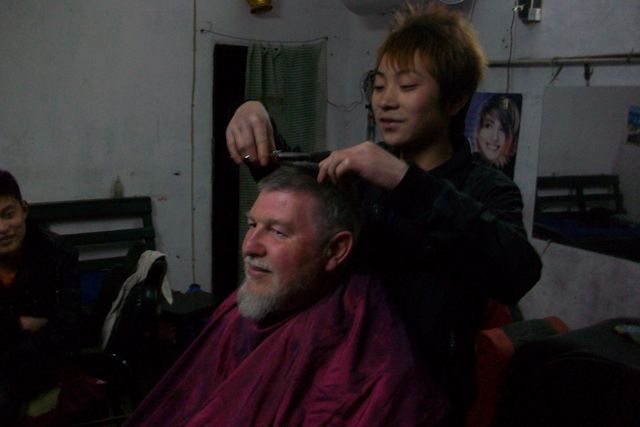

6 March 2011
I've produced a DVD of this trip and also of the many other trips I've made to China from the 1990s to date. Click here to see the list of all my China DVDs.
Around 8 March, a Bago Steam blog focussing on the railway should be available here.
If you are interested to read about how the new road that will link Bagou to the outside world is progressing, click here.
2 March 2011
A change in breakfast routine today meant that we had bananas, breadsticks and coffee as a change from steamed buns and soy milk with rice. We planned an easy day today starting from the railway station in Bagou with a walk along the lower truck road up to the north ridge above Huangcunjin and leading into the the north-west passage walk. This was a combination of walks based on Rob's descriptions to which we added our own variations when we lost his trails. First, we encountered stonemasons preparing stones most likely for building a grave. Bodies that are buried here go into family tombs on the hillside.


We were well below the ridge and passed a number of traditonal farmhouses like this, and people working in the fields. It is not yet time for rice planting.

This was a good day for bird-watching and we saw several flocks of light-vented bulbuls among other sightings.

This squirrel we heard and were very pleased to see it at such close quarters eating a nut.

The views down to the lower valleys and distant hills, although hazy were spectacular from the top.

The truck road along the ridge is not so exciting but it gets you around to points where you can drop down to Huangcunjing along some magical paths. We don't think we found the same path that Rob and Yuehong used but it worked all the same. John called this a cathedral of bamboo along our steep descent.

Even on the narrowest of paths, steps are carved into the hillside.

Our smaller path brought us up to one we possibly missed coming off the main ridge track.

We came down to this farmhouse to ask the lady if we were going in the right direction. She kindly sent us off on a route around her rice paddies to meet the main trail down to Huangcunjin.

This was the familiar view at last of the old coal area at Huangcunjin after a three and a half hour hike with the new mining museum headstock just visible middle left. By this point we were totally unlost.

Right place and right time - miners' canteen just after the miners' lunch hour ended at one pm. We were welcomed as usual and chose our meat and vegetables to be cooked.

Liver on the left and pork on the right

Heading back towards Bagou, they have done a good job at cleaning up the river so that we could see the reflections of the trees. A lady was painting all the stems with a lime wash to prevent insect damage. Since we have been here the leaves are beginning to emerge and spring seems to have arrived.

A bonus today was seeing the second coal train of the day come up to take coal down from the mine, so John did not miss a photo opportunity!

The man standing is one of the two brake men on this train ready to head for Shibanxi. The loco is No. 7.

3 March 2011
Rain continued through the night, but it was fine first thing as we ate our breakfast of bread stick and banana with coffee at the entrance to our guest house, just watching the world go by. The gentleman on the left is still wearing his Mao suit, with trouser legs rolled up. He is buying plastic to make cloches over his crops which was sold by weight not by length.

We set off for a very long trek up and over the mountains to a town on the river a few valleys away called Huangdan. The first part of the walk up and out of our valley was familiar, but took us twice as long as the rain had turned the trail to sticky (and slippery) mud.

When we could look up there were of course lovely views, and the weather got better and better as the day wore on. This is the village Tong Qian Ao, with reflections in the village pond.

About one km from this village there is a coal mine, and we met these coal pickers heading down to the slag heap.

Here they do a good job of picking it over for pieces of coal - this is a job mainly for women. The coal mine was working, and although small, quite a modern operation using trucks, because here a concrete road began all the way down to the river about 4 kms below.

We, of course, walked the road round and down, and had wonderful views all the way, heightened by the rape flowers, and also plum blossom beginning to flower over the mountainsides.

We were pleased to see the river below, but did not realise that we had another five kilometers on the flat to get to Huangdan.

As always we are fascinated by the daily lives of people - here they were building new public toilets in a hamlet, but notice the unsupervised baby at the top of the steps!

Once we hit the river we headed up stream, and came across a huge dam.

This really was a delightful view of Huangdan as we approached - by this time it was something of an effort walking along the road after four hours of walking.

Made even more photogenic when the small boat began to cross

This was the first town we have really visited, and we certainly created a bit of a stir as this is a long way off any foreign tourist tracks. The bowl of noodles were most welcome, and we chose to have them 'la-da' - spicy.

Wandering the market area we found all sorts of transport in use from cars to bicycle rickshaws

There are firecrackers on sale everywhere - most days we hear them going off somewhere.

On the street, along with mahjong and cards, we found this game of Chinese chess. Although gambling is banned we watch a lot of money changing hands over cards and mahjong each day - the Chinese love to gamble.

With tired legs and a long way back, we managed to hire a couple of motor biked to take us the first 10 kms along the dam and up the hill to Tong Qian Ao. This involved a little bargaining - we managed to get the ride for 25 each - £2.50 - it was worth every penny, though a bit scary at times!!

We rested up in this village and chatted with the people - a serious game of cards was going on in the shop. Notice the man smoking a cigar - this is quite common here, but just for the men.

We had chatted to this lady on the way down, but now she was showing off her lovely baby. As can be seen with the other little girl, they are swathed in layer upon layer of clothes for the winter, always ending with a pinafore. I think it is worth saying at this point that no-one in Bagou or indeed any of these villages speaks any English. There are no schools, so the children go somewhere else to be taught, and there are no professionals that may have learned some.

Brilliant to get a view on a clear day of the lovely farming country in the high valleys


Last view from the top of the hill looking down on the train station at Bagou, John caught a glimpse of the afternoon train which was 45 minutes late! I was particularly pleased to see 'home' in sight after a pretty exhausting trek.

4 March 2011
The weather rather spoilt itself today with very low cloud and cold, so the photos are all rather hazy. Undeterred we got up so early that even the breakfast stalls were not operating. We did manage to buy breadsticks to take with us and had a banana for breakfast. The walk started by going through the two railway tunnels out of Bagou along the tracks - we are grateful for our torches, and we did wait for the first train to go through!!
The explorations started at Jiaoba, the next stop down the line where there used to be a coalmine, but no longer. We headed out on the north side up into a whole different set of valleys with steep cliffs, first passing a fishing pond.

The farmhouses do not have chimneys, but when they light the fires for cooking the smoke just seeps through the roof.

We had a wonderful sighting of what we believe to be a Common Buzzard, we saw it fly into the tree and got a really good look from close quarters. We came back to the same area three hours later and it was still wheeling around.

Just as we turned to head up another side valley we caught sight of this old stone bridge - part of a former path system. If it hadn't been for its location amongst rice paddies it would have been equally at home in Scotland.

We headed up the road to the site of an old coal mine - last time John was here in 2007 this had still been in full production.

Now, all that is left are the slag heaps and remnants - the mine entrance had been concreted up.

We however climbed way above the mine to find the footpath back towards Jiaoba. This lady was gathering wood for her fire, carried on top of the bamboo basket.

The trail was really spectacular as we were on top of cliffs (sometimes rather close to the edge) like the ones across the valley here.

It was a great walk for bird watching, and as well as the more exotics, we saw flocks of Great Tits.

For much of the way the path had stone slabs, which must hve been such a bonus for all the farmers when it is wet. Having had that muddy experience yesterday, I can really appreciate that.


This is John amongst the fast growing Eucalyptus trees which have been planted extensively in the area. We wonder whether they will be as suitable as pine for use as pit props.

This grave had recently been renovated and looked very smart.

So here we were back at the fishing ponds after a great circular hike which had taken about 3 hours.

We just had the tunnels to negotiate between trains, and then were safely back in Bagou in time for lunch. In the afternoon we walked down to Huancunjin, and then bought dried chillis, mushrooms, fungus, star anise and Sichuan Prickly Ash for John's Chinese creations back at Marigold.
Saturday 5 March 2011
Cold! I talked about children being bundled up in many layers, but that was us - I had six layers on for most of the day and just about felt comfortable. We went out to buy breakfast bread sticks and steamed buns. It costs 10p for two breadsticks and 10p for a steamed bun!

We ate these, along with bananas we had bought in the market, and drank our own filter coffee at the entrance to our hotel. We are about to run out of the latter, but John has supplies coming in from the UK with his group. Our room is the door on the left.

The view looking out is of the little shop where we bought our dried supplies to go back to the UK.

After breakfast we had a wander round the market, passing this tailor en route.

Now this is something I know we don't do at home any more, but the tinsmith replaces the bottom of kettles, pots and woks

He hammers the join to make sure it is secure.

Knitters abound, even in the early morning market while shopping - the small bag over the arm carries the wool.

In the square it was pretty exciting even early morning as there was a 'croquet' competition. (Knitting still goes on!)

The spectators as always are as interesting as the players. Normally it is the men who play, but women definitely featured in the competition.

We finally set out for our hike around 9am. It was a very steep ascent from near Huangcunjing, starting up an incline of a former slag heap. There are stone steps all the way, which in this case helps. From the top, we walked across what is now farmland, and then ascended a steep slope to the top of the ridge. It was one of those very hazy days, so there were not great views, but it was atmospheric! The ridge walk was again up and down - Rob had equated it to the Great Wall of China, and I was just pleased that by this time we were pretty fit! There were sheer drops either side.

We were pleased to reach a high plateau that was farmed, and we could see high habitations over the far side which we took to be down towards Huangdan.

We did eventually come across the familiar sight of the Huangcunjing coal mine below, and wended our way round and down to the canteen there for lunch at 1 pm.

Afterwards we wandered down to the railway and decided to do the tour of the coal mine available for tourists. In fact this was brilliant, despite us having to get dressed up. It is actually in a section of the old mine, and you needed to be guided through it all. We were the only people in the mine at the time. We entered here, were checked for contraband (cigarettes, lighters, etc.) and were locked in. The beginning was a steep descent down steps, in the original tunnels built by the Sino-British consortium. We only, of course, saw a small santised part of the extensive workings, but the displays and the tour were very well done. It took about half an hour, and at the end you ascend 46m in a lift to the surface. Just as we were leaving a tourist group of 150 school children arrived by train, so it was especially good timing!

We got to get our photos taken with the loco - contrast the lady who has just got off the train!

John, to his delight, was invited onto the engine!

In one of those bizarre occurrences, when we got back to our guest house these two ladies walked into the shop opposite. I recognized the man with them as the famous photographer who has written a photo book which we have about this area and the railway. I congratulated him on his book and he told me these were models were up here for a photo shoot, and so here we are ...

We ended Stephanie's last night in Bagou with a meal at our breakfast restaurant sitting out on the pavement and attracting the local middle-school lads and some of the visiting Chinese photographers.

As part of our promenade, we stopped off at the hairdresser for John to have a trim. It's hard to beat £1.50 for a haircut, shampoo, head massage and beard and moustache trim.

6 March 2011
This was the last morning waking up in our simple room in Bagou.We had breakfast in our room as there were other people staying and they had taken the chairs from the entrance. We then did our seventy paces round a very active market, and extended it to an area we have only seen a little of, to look at the connecting corridors and balconies.

The houses are still so traditional, but new door gods and today's washing show that they are very much in use, with every inch of space used for growing something edible!

We packed and said our farewells, making our way for the second train of the day down to Sanjing. It was so busy with local tourists that they had to put on an extra two carriages from Bagou!

The crowds were hard to control - it was a nightmare for the station master.

Irrepressible, the knitters were still at it on the platform.

A group of photogaphers were in the 'staff carriage', but the guards let us in, so we were lucky to have a seat for my final trip down the line. We are now both sporting new haircuts!

We got off the train in Sanjing and walked to the local bus station, where a bus was just leaving for Qianwei, the nearby town where we were to spend the night. It was around a half hour journey, and I quickly learned that there were no traffic rules - we spent more time on the wrong side of the road than on the right. We were heading for the 'big city', and suddenly the contrast with the serenity of the mountains was apparent.
John knows the place, so we hopped off the bus before the bus station and walked to our hotel - Tian Bo - the very best in town. We are staying in the brand new wing, a very posh room with western style toilet and bathroom, oh so very nice, and all for £22 per night. This is luxury of a different sort.

After leaving our bags we set off to find lunch and explore the town. We had a local special dish of steamed meat and savoury rice flour, then went to buy our long distance bus ticket for Chengdu for tomorrow morning, before joining the crowds out for a Sunday wander. There was lots of noise of bicycle rickshaw (driven by women), scooters, cars, and even little ones like this!

This chap was catching up on sleep before probably offering a lift to shoppers.

There was a lovely pedestrian area, with seating round all the trees which was in full use, and maybe everyone has knitted their own hat!

The other pastime we have observed daily is that love of cards and mahjong, when always a little money also changes hands.

Final thoughts to follow? Otherwise, that is the end of our Bagou blog. John will probably document the steam tour but with a focus on the railway rather than the environment. When started around 8 March, it should be available here.
------------------------------
Email comments to:
![]()